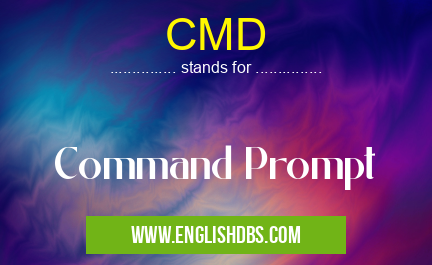What does CMD mean in DOS COMMANDS
CMD is an abbreviation that stands for Command Prompt, a command-line interpreter program included with Microsoft Windows operating systems. CMD allows users to interact with the system using text-based commands, providing a powerful tool for system administration, troubleshooting, and automating tasks.

CMD meaning in DOS Commands in Computing
CMD mostly used in an acronym DOS Commands in Category Computing that means Command Prompt
Shorthand: CMD,
Full Form: Command Prompt
For more information of "Command Prompt", see the section below.
What is Command Prompt?
CMD is a text-based user interface (TUI) that enables users to execute commands and run programs by typing instructions into the command window. It provides a direct interface to the Windows command interpreter, known as cmd.exe, allowing users to control various aspects of the operating system.
Features of Command Prompt
- Command Execution: CMD allows users to execute commands, which are instructions recognized by the command interpreter. These commands can be used to perform a wide range of tasks, such as creating and managing files, running programs, and changing system settings.
- Batch File Creation: CMD supports the creation of batch files, which are text files containing a sequence of commands. Batch files can automate repetitive tasks and streamline system administration.
- Command History: CMD maintains a history of executed commands, allowing users to easily recall and reuse previous commands.
- Task Scheduling: CMD can be used to schedule tasks, such as running programs or executing scripts at specific times or intervals.
- System Control: CMD provides access to system resources and allows users to control aspects of the operating system, such as managing user accounts, configuring network settings, and troubleshooting system issues.
Essential Questions and Answers on Command Prompt in "COMPUTING»DOS"
What is Command Prompt (CMD)?
Command Prompt (CMD) is a command-line interface tool built into Microsoft Windows operating systems. It provides a way to control the computer, run programs, and execute system commands by typing commands directly into the command window.
How do I open Command Prompt?
There are several ways to open Command Prompt:
- Type "cmd" in the Windows search bar and select the "Command Prompt" app.
- Press "Windows Key + R" to open the Run dialog box, type "cmd" and press Enter.
- In File Explorer, navigate to "C:\Windows\System32" and double-click on the "cmd.exe" file.
What are the basic commands in Command Prompt?
Some basic commands include:
- dir: Lists files and directories.
- cd: Changes the current directory.
- mkdir: Creates a new directory.
- del: Deletes a file.
- copy: Copies a file or directory.
- move: Moves a file or directory.
Can I run programs in Command Prompt?
Yes, you can run programs in Command Prompt by typing the program's executable file name followed by any necessary arguments. For example, to run the notepad program, you would type "notepad" and press Enter.
How do I execute system commands in Command Prompt?
Many system commands are available in Command Prompt, such as shutdown, restart, and netstat. To execute a system command, simply type the command name and any required parameters. For example, to shut down the computer, type "shutdown /s" and press Enter.
What are command prompt arguments?
Command prompt arguments are additional parameters that can be passed to a command to modify its behavior. Arguments typically follow the command name and are separated by spaces. For example, the "dir" command can be used with the "/w" argument to display file listings in a wide format.
Can I save and reuse Command Prompt commands?
Yes, you can create batch files to save and reuse multiple Command Prompt commands. Batch files are text files with the ".bat" extension that contain a series of commands. To run a batch file, simply double-click on it or type its name (without the ".bat" extension) in Command Prompt.
Is Command Prompt the same as PowerShell?
No, Command Prompt and PowerShell are different command-line tools in Windows. PowerShell is a more advanced tool that provides additional features and support for scripting and automation. While Command Prompt is still widely used, PowerShell is becoming increasingly popular for system administration and scripting tasks.
Final Words: CMD is a versatile and powerful tool for Windows users, providing a command-line interface to interact with the operating system. Its features enable users to perform a wide range of tasks, from system administration to automating tasks and troubleshooting issues. Understanding the functionality and usage of CMD can significantly enhance the efficiency and productivity of Windows users.
CMD also stands for: |
|
| All stands for CMD |
